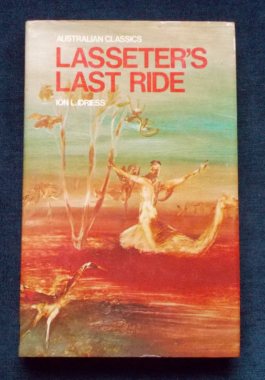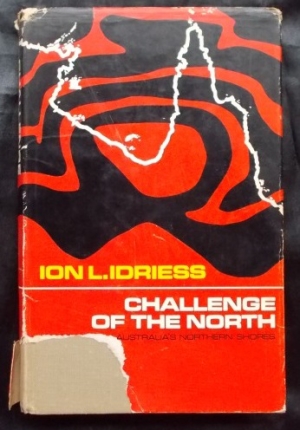From the Author's Note: The stories in this volume record happenings in men's lives which interested me during years of wandering among the bushmen and natives of Cape York Pensinsula; the pearlers, trochus and beche-de-mer getters of the Coral Sea; the native islanders of Torres Strait; the beach-combers of the Great Barrier Reef...with two exceptions all are transcripts of fact or are largely based on fact...I hope Colonel Woodman, Bert Vigden of Thursday Island, Bert Jardine of Somerset and others will not mind their names being mentioned. My old mate Dick Welch, I know, will not; neither will "Scandalous" Graham. "Scandalous" may swear a lot and say harsh things about me, then quietly show the book in almost every shearing shed in New South Wales and Queensland, That is, if he's "out of trouble." It doesn't get any better than that!
- Sorry, this product is unavailable.
-


-
 His claims of finding an Australian El Dorado have been questioned, even ridiculed. His diary clues are cryptic. His reef has never been found but the legend of Lasseter's Reef persists to taunt the reason and entice the imagination. Is there a long lost reef still waiting for the stumbling foot of a latter day Lasseter to turn up Gold? This story has been written from the related experiences of members of the expedition, and from the letters of Lasseter. The story of Lasseter's last adventures has been pieced together from the fragments of letters buried by him beneath the ashes of his camp-fires and found by Bob Buck when he was searching for the lost prospector; so this is the real life epic of the expedition into the dead heart of Australia to search for his legendary reef of gold, to find again that fabulous place at the edge of the desert where 'the yellow stuff was as thick as plums in pudding'.
His claims of finding an Australian El Dorado have been questioned, even ridiculed. His diary clues are cryptic. His reef has never been found but the legend of Lasseter's Reef persists to taunt the reason and entice the imagination. Is there a long lost reef still waiting for the stumbling foot of a latter day Lasseter to turn up Gold? This story has been written from the related experiences of members of the expedition, and from the letters of Lasseter. The story of Lasseter's last adventures has been pieced together from the fragments of letters buried by him beneath the ashes of his camp-fires and found by Bob Buck when he was searching for the lost prospector; so this is the real life epic of the expedition into the dead heart of Australia to search for his legendary reef of gold, to find again that fabulous place at the edge of the desert where 'the yellow stuff was as thick as plums in pudding'. -
Sale!

The Challenge Of The North: Ion Idriess
$95.00$80.00Houses under the Barrier Reef sea, a fish trap hundreds of miles wide across the Gulf of Carpentaria, power from our rugged, daunting Kimberley coast, sea-beef for the world's growing population...Pipe dream or reality? Dreamer - or prophet? First published in 1969, this is Idriess' lifetime of observation of the seas and shores north of Capricorn, magnified to a vision of the potential of Australia's tropical animal, plant and fish life, and of the earth's unrevealed and untapped wealth. Idriess saw the Continental Shelf as a vast reserve of food and riches that, with careful conservation, outlast the mineral rushes and exploitation of the land. He forecast what needed to be done to protect these resources and how to use them to advantage; he warned of the danger of creating a desert beneath the sea and of the devastation of the land resulting from thoughtless destruction of the Great Barrier Reef. Even as far back as 1969, Idriess saw the need for a demand for action on political, conservation and economic levels. -

 A group of convicts escape from Norfolk Island in a boat. Only one survives - by killing and eating his companions en route for sustenance until he arrives on Badu Island. He takes over leadership of the natives by besting - then decapitating - the chief. The natives believe him to be the reincarnation of Wongai, friend of the gods, and accept him without question. Their acceptance is tinged with reverence when theydiscover that he is an astute war leader and knows something of agriculture. This tale of the European convict who rose to power in the 1840s as a tribal chief, is based on fact - from the ships log of the HMS Rattlesnake, captained by Owen Stanley. Billy Winn, an escaped convict from Norfolk Island, had, through a reign of terror and treachery, cowed the most fearful of all peoples - the Coral Sea headhunters.
A group of convicts escape from Norfolk Island in a boat. Only one survives - by killing and eating his companions en route for sustenance until he arrives on Badu Island. He takes over leadership of the natives by besting - then decapitating - the chief. The natives believe him to be the reincarnation of Wongai, friend of the gods, and accept him without question. Their acceptance is tinged with reverence when theydiscover that he is an astute war leader and knows something of agriculture. This tale of the European convict who rose to power in the 1840s as a tribal chief, is based on fact - from the ships log of the HMS Rattlesnake, captained by Owen Stanley. Billy Winn, an escaped convict from Norfolk Island, had, through a reign of terror and treachery, cowed the most fearful of all peoples - the Coral Sea headhunters. -

 Two volume set in slipcase: Miners And Soldiers: The Silver City: Broken Hill in the early 1900s was a hell on earth. Idriess draws on his childhood experiences there to evocatively describe what life was like: Flies and dust and isolation, the deadening feeling that no-one else in the world knew or cared whether we lived or died out there...typhoid, pneumonia, dysentery and lead poisoning...so did the dirty brown water, so frightfully expensive, that in drought time came rumbling up in water trains from South Australia. He also conveys an acute sense of his distress at the despoilation of the natural world by wave after wave of settlers. Lightning Ridge: Idriess almost died he almost died in the typhoid epidemic that killed his mother and he was sent to his grandmother in Sydney.He found work on a paddle-steamer on the run to Newcastle. After a typhoid fever relapse he worked in the western districts of New South Wales in various jobs. Then the call of opals drew him - like so many other young men - to Lightning Ridge in about 1910 and although he did not strike it rich, he wrote short pieces for The Bulletin about life on the opal fields. The Desert Column: One of Idriess' earliest works, published in 1932 and based on the diaries that he kept throughout the war. driess served as a sniper with the 5th Australian Light Horse. Enlisting in 1914, he began his diary, As we crowded the decks off Gallipoli and he continued writing until returning to Australia. The diaries cover his experiences of life in the trenches at Gallipoli to the battles at Romani and Beersheba. Heroes Of The Outback: The Cattle King: an inspiring tribute to the remarkable life of Sir Sidney Kidman - the Cattle King. At the age of 13 Sidney Kidman ran away from home with only five shillings in his pocket. He went on to become a horse dealer, drover, cattle buyer and bush jockey and he also ran a coach business. Above all, Kidman created a mighty cattle empire of more than a hundred stations, fighting droughts, bushfires, floods and plagues of vermin to do so. His enterprise and courage won him a huge fortune and made him a legend. Flynn of the Inland: The true story of the man who pioneered the Flying Doctors and Bush Hospitals of Australia in the early 1900's. Ever the dreamer, Flynn did not rest until his dream of saving lives in the bush was realised through a revolutionary new system of using light aeroplanes as ambulances to help overcome the problems of distance in the huge Australian Outback. Lasseter's Last Ride: Having himself been a prospector, the story Idriess constructed out of the fragments of documentary evidence — a few reports, the barely legible diary and letters found buried near Lasseter's last camps - is probably very close to what actually happened. Harry Lasseter had once discovered a rich gold reef in unexplored west Central Australia. Owing to a faulty watch, the bearings he took were useless. An expedition was fitted out to locate it. From the first, misfortune dogged the steps of the party. Food ran short and they returned to the base-camp - all except Lasseter, who went on alone. When his two camels bolted he was left waterless in the desert. Blinded by sand and tortured by dysentry, he found the reef, but died shortly afterwards, deserted by a tribe of aborigines with whom he had tried to make friends. Mr. Idriess tells this story in a simple, virile style which is, in its intense economy, comparable to Hemingway at his best.
Two volume set in slipcase: Miners And Soldiers: The Silver City: Broken Hill in the early 1900s was a hell on earth. Idriess draws on his childhood experiences there to evocatively describe what life was like: Flies and dust and isolation, the deadening feeling that no-one else in the world knew or cared whether we lived or died out there...typhoid, pneumonia, dysentery and lead poisoning...so did the dirty brown water, so frightfully expensive, that in drought time came rumbling up in water trains from South Australia. He also conveys an acute sense of his distress at the despoilation of the natural world by wave after wave of settlers. Lightning Ridge: Idriess almost died he almost died in the typhoid epidemic that killed his mother and he was sent to his grandmother in Sydney.He found work on a paddle-steamer on the run to Newcastle. After a typhoid fever relapse he worked in the western districts of New South Wales in various jobs. Then the call of opals drew him - like so many other young men - to Lightning Ridge in about 1910 and although he did not strike it rich, he wrote short pieces for The Bulletin about life on the opal fields. The Desert Column: One of Idriess' earliest works, published in 1932 and based on the diaries that he kept throughout the war. driess served as a sniper with the 5th Australian Light Horse. Enlisting in 1914, he began his diary, As we crowded the decks off Gallipoli and he continued writing until returning to Australia. The diaries cover his experiences of life in the trenches at Gallipoli to the battles at Romani and Beersheba. Heroes Of The Outback: The Cattle King: an inspiring tribute to the remarkable life of Sir Sidney Kidman - the Cattle King. At the age of 13 Sidney Kidman ran away from home with only five shillings in his pocket. He went on to become a horse dealer, drover, cattle buyer and bush jockey and he also ran a coach business. Above all, Kidman created a mighty cattle empire of more than a hundred stations, fighting droughts, bushfires, floods and plagues of vermin to do so. His enterprise and courage won him a huge fortune and made him a legend. Flynn of the Inland: The true story of the man who pioneered the Flying Doctors and Bush Hospitals of Australia in the early 1900's. Ever the dreamer, Flynn did not rest until his dream of saving lives in the bush was realised through a revolutionary new system of using light aeroplanes as ambulances to help overcome the problems of distance in the huge Australian Outback. Lasseter's Last Ride: Having himself been a prospector, the story Idriess constructed out of the fragments of documentary evidence — a few reports, the barely legible diary and letters found buried near Lasseter's last camps - is probably very close to what actually happened. Harry Lasseter had once discovered a rich gold reef in unexplored west Central Australia. Owing to a faulty watch, the bearings he took were useless. An expedition was fitted out to locate it. From the first, misfortune dogged the steps of the party. Food ran short and they returned to the base-camp - all except Lasseter, who went on alone. When his two camels bolted he was left waterless in the desert. Blinded by sand and tortured by dysentry, he found the reef, but died shortly afterwards, deserted by a tribe of aborigines with whom he had tried to make friends. Mr. Idriess tells this story in a simple, virile style which is, in its intense economy, comparable to Hemingway at his best. -

 A light-hearted, adventure story, set on the Great Barrier Reef around Lizard Island and Cooktown, of two young boys who join a trochus shell fishing boat and cruise to Lizard Island. A story for young adults, and it is NOT about opium or any other drug.
A light-hearted, adventure story, set on the Great Barrier Reef around Lizard Island and Cooktown, of two young boys who join a trochus shell fishing boat and cruise to Lizard Island. A story for young adults, and it is NOT about opium or any other drug. -
 This volume contains: The Cattle King: an inspiring tribute to the remarkable life of Sir Sidney Kidman - the Cattle King. At the age of 13 Sidney Kidman ran away from home with only five shillings in his pocket. He went on to become a horse dealer, drover, cattle buyer and bush jockey and he also ran a coach business. Above all, Kidman created a mighty cattle empire of more than a hundred stations, fighting droughts, bushfires, floods and plagues of vermin to do so. His enterprise and courage won him a huge fortune and made him a legend. Flynn of the Inland: The true story of the man who pioneered the Flying Doctors and Bush Hospitals of Australia in the early 1900's. Ever the dreamer, Flynn did not rest until his dream of saving lives in the bush was realised through a revolutionary new system of using light aeroplanes as ambulances to help overcome the problems of distance in the huge Australian Outback. Lasseter's Last Ride: Having himself been a prospector, the story Idriess constructed out of the fragments of documentary evidence — a few reports, the barely legible diary and letters found buried near Lasseter's last camps - is probably very close to what actually happened. Harry Lasseter had once discovered a rich gold reef in unexplored west Central Australia. Owing to a faulty watch, the bearings he took were useless. An expedition was fitted out to locate it. From the first, misfortune dogged the steps of the party. Food ran short and they returned to the base-camp - all except Lasseter, who went on alone. When his two camels bolted he was left waterless in the desert. Blinded by sand and tortured by dysentry, he found the reef, but died shortly afterwards, deserted by a tribe of aborigines with whom he had tried to make friends. Mr. Idriess tells this story in a simple, virile style which is, in its intense economy, comparable to Hemingway at his best.
This volume contains: The Cattle King: an inspiring tribute to the remarkable life of Sir Sidney Kidman - the Cattle King. At the age of 13 Sidney Kidman ran away from home with only five shillings in his pocket. He went on to become a horse dealer, drover, cattle buyer and bush jockey and he also ran a coach business. Above all, Kidman created a mighty cattle empire of more than a hundred stations, fighting droughts, bushfires, floods and plagues of vermin to do so. His enterprise and courage won him a huge fortune and made him a legend. Flynn of the Inland: The true story of the man who pioneered the Flying Doctors and Bush Hospitals of Australia in the early 1900's. Ever the dreamer, Flynn did not rest until his dream of saving lives in the bush was realised through a revolutionary new system of using light aeroplanes as ambulances to help overcome the problems of distance in the huge Australian Outback. Lasseter's Last Ride: Having himself been a prospector, the story Idriess constructed out of the fragments of documentary evidence — a few reports, the barely legible diary and letters found buried near Lasseter's last camps - is probably very close to what actually happened. Harry Lasseter had once discovered a rich gold reef in unexplored west Central Australia. Owing to a faulty watch, the bearings he took were useless. An expedition was fitted out to locate it. From the first, misfortune dogged the steps of the party. Food ran short and they returned to the base-camp - all except Lasseter, who went on alone. When his two camels bolted he was left waterless in the desert. Blinded by sand and tortured by dysentry, he found the reef, but died shortly afterwards, deserted by a tribe of aborigines with whom he had tried to make friends. Mr. Idriess tells this story in a simple, virile style which is, in its intense economy, comparable to Hemingway at his best.


